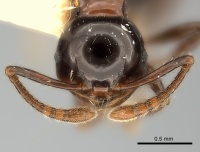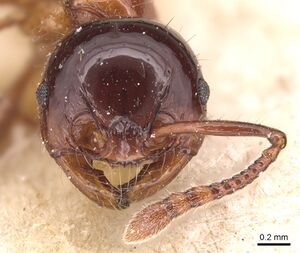Pristomyrmex lucidus
| Pristomyrmex lucidus | |
|---|---|

| |
| Scientific classification | |
| Kingdom: | Animalia |
| Phylum: | Arthropoda |
| Class: | Insecta |
| Order: | Hymenoptera |
| Family: | Formicidae |
| Subfamily: | Myrmicinae |
| Tribe: | Crematogastrini |
| Genus: | Pristomyrmex |
| Species: | P. lucidus |
| Binomial name | |
| Pristomyrmex lucidus Emery, 1897 | |
This species occurs in rainforest and has been collected in soil under a log, under the bark of a rotten log, in litter samples, and on the ground.
Identification
Wang (2003) - Worker. Masticatory margin of mandible lacking a diastema and possessing four teeth, of which the third tooth, counting from the apex, smallest; HW 0.98-1.26, HL 0.92-1.16; postpetiole in dorsal view longer than broad or as long as broad, in profile with an arched anterior face and a steeply sloping posterior face; petiole node in profile with a single evenly rounded blunt apex.
The workers of P. lucidus can be easily recognized by the following characters: (1) The postpetiole, in profile view, shows an arched anterior face and a steeply sloping posterior face, with the apex pointing posterior-upwardly. This shape is unique in the levigatus group. Furthermore, the postpetiole in dorsal view is longer than or as long as broad. In the other 11 species of the group, the postpetiole, in dorsal view, is distinctly broader than long. (2) The petiole node in profile view bears a single evenly blunt-rounded apex that is not seen in the other 11 species of the levigatus group. (3) P. lucidus has the largest head width (HW) in the levigatus group: In the .5.5 specimens measured, HW is 1.00 to 1.26 but 0.98 in only one individual. In the other species of the levigatus group, HW is less than 0.90, except in one species, Pristomyrmex largus, in which, HW falls into the range 0.90 to 0.96.
A member of the Levigatus species group
Keys including this Species
Distribution
Latitudinal Distribution Pattern
Latitudinal Range: -2.683330059° to -8.949999809°.
| North Temperate |
North Subtropical |
Tropical | South Subtropical |
South Temperate |
- Source: AntMaps
Distribution based on Regional Taxon Lists
Indo-Australian Region: New Guinea (type locality).
Distribution based on AntMaps
Distribution based on AntWeb specimens
Check data from AntWeb
Countries Occupied
| Number of countries occupied by this species based on AntWiki Regional Taxon Lists. In general, fewer countries occupied indicates a narrower range, while more countries indicates a more widespread species. |

|
Estimated Abundance
| Relative abundance based on number of AntMaps records per species (this species within the purple bar). Fewer records (to the left) indicates a less abundant/encountered species while more records (to the right) indicates more abundant/encountered species. |

|
Biology
|
Castes
Queens have yet to be collected.
Worker
Images from AntWeb
   
| |
| Holotype of Pristomyrmex lucidus. Worker. Specimen code casent0904698. Photographer Will Ericson, uploaded by California Academy of Sciences. | Owned by MSNG, Genoa, Italy. |
Nomenclature
The following information is derived from Barry Bolton's Online Catalogue of the Ants of the World.
- lucidus. Pristomyrmex lucidus Emery, 1897c: 584 (w.) NEW GUINEA. Donisthorpe, 1948b: 305 (q.). See also: Wang, M. 2003: 503.
Unless otherwise noted the text for the remainder of this section is reported from the publication that includes the original description.
Description
Worker
Wang (2003) - TL 3.71-4.84, HL 0.92-1.16, HW 0.98-1.26, CI 104-111, SL 0.90-1.16, SI 89-98, EL 0.16- 0.20, PW 0.62-0.79, AL 0.90-1.28, PPW 0.24-0.28, PPL 0.26-0.31, PPI 84-100 (n = 55).
Mandibles smooth and shining but sometimes with a few longitudinal rugae superficial or distinct. A broad-based short tooth present about midway on the basal margin of the mandible. Clypeus with a short median longitudinal carina that usually does not reach to the anterior clypeal margin; sometimes this carina indistinct; sometime s a few additional short rugae present. Anterior clypeal margin with a median tooth and two lateral teeth; sometimes the median tooth is smaller than the others. Ventral surface of clypeus lacking any rugae or teeth. Palp formula 1,3. Frontal carinae extending to the level of the posterior margins of eyes. Antennal scrobes absent. Frontal lobes slightly expanded basally. Eyes containing 7 to 10 ommatidia in the longest row. Pronotum at most with a pair of blunt tubercles, lacking teeth or spines. Propodeum with a pair of armaments, varying from broadly based minute teeth to moderately long acute spines. Metapleural lobes triangular or each with a blunt-rounded apex. Petiole node in profile high, with a single evenly blunt-rounded apex and a long anterior peduncle . Postpetiole in profile high (slightly higher than petiole), with an arched anterior face and a steeply sloping posterior face , its apex pointing posterior-upwardly. In dorsal view, postpetiole broadening from front to back, mostly longer than broad, rarely about as long as broad. Cephalic dorsum between the frontal carinae highly polished but usually with a few foveolate punctures bordering the frontal carinae. Sometimes a few foveolate punctures present on the genae and many on the ventral surface of the head. Dorsum of alitrunk, petiole, and postpetiole unsculptured and highly polished. Gaster smooth and shining. Dorsal surfaces of head and alitrunk with sparse erect to suberect moderately long hairs. A pair of hairs present on the dorsum of petiole node and one to two pairs on the dorsum of postpetiole. First gastral tergite with a few hairs. A few pairs of forward-projecting hairs present near the anterior clypeal margin. Scapes and tibiae with numerous suberect to erect short hairs. Body uniform yellow-brown or blackish-brown or bicolored (i.e., alitrunk and pedicel segments lighter than head and gaster).
Queen
Wang (2003) - TL 5.12, 5.22; HL 1.13, 1.14; HW 1.22, 1.27; CI 108, 111; SL 1.06, 1.13; SI 87, 89; EL 0.26, 0.28; PW 0.96, 1.00; AL 1.40, 1.42; PPW 0.31, 0.36; PPL 0.32, 0.38; PPI 9.5, 97 (n = 2).
Generally similar to worker, except for normal caste differences. In addition, propodeal armaments usually shorter than those in the conspecific worker; first gastral tergite sometimes with numerous erect or suberect hairs.
Type Material
Wang (2003) - Holotype worker, New Guinea: Berlinhafen (Biro) (Museo Civico di Storia Naturale, Genoa) [examined].
References
- Cantone S. 2018. Winged Ants, The queen. Dichotomous key to genera of winged female ants in the World. The Wings of Ants: morphological and systematic relationships (self-published).
- Donisthorpe, H. 1948b [1947]. A second instalment of the Ross Collection of ants from New Guinea. Ann. Mag. Nat. Hist. 11(14): 297-317 (page 305, queen described)
- Emery, C. 1897c. Formicidarum species novae vel minus cognitae in collectione Musaei Nationalis Hungarici quas in Nova-Guinea, colonia germanica, collegit L. Biró. Természetr. Füz. 20: 571-599. (page 584, worker described)
- Wang, M. 2003. A Monographic Revision of the Ant Genus Pristomyrmex (Hymenoptera:Formicidae). Bulletin of the Museum of Comparative Zoology 157(6): 383-542 (page 503, figs. 221-224 worker, queen described)
References based on Global Ant Biodiversity Informatics
- CSIRO Collection
- Donisthorpe H. 1948. A second instalment of the Ross Collection of ants from New Guinea. Annals and Magazine of Natural History (11)14: 297-317.
- Donisthorpe H. 1949. A fifth instalment of the Ross Collection of ants from New Guinea. Annals and Magazine of Natural History (12)1: 487-506.
- Emery C. 1897. Formicidarum species novae vel minus cognitae in collectione Musaei Nationalis Hungarici quas in Nova-Guinea, colonia germanica, collegit L. Biró. Természetrajzi Füzetek 20: 571-599.
- Janda M., G. D. Alpert, M. L. Borowiec, E. P. Economo, P. Klimes, E. Sarnat, and S. O. Shattuck. 2011. Cheklist of ants described and recorded from New Guinea and associated islands. Available on http://www.newguineants.org/. Accessed on 24th Feb. 2011.
- Laciny A., H. Zettel, A. Pal, and D. Zimmermann. 2016. The ant genus Pristomyrmex (Insecta: Hymenoptera: Formicidae) in the collection of the Natural History Museum Vienna. Ann. Naturhist. Mus. Wien B 118: 61-72.
- Snelling R. R. 2000. Ants of the Wapoga river area, Irian Jaya, Indonesia. In Mack, Andrew L. and Leeanne E. Alonso (eds.). 2000. A Biological Assessment of the Wapoga River Area of Northwestern Irian Jaya, Indonesia. RAP Bulletin of Biological Assessment 14, Conservation International, Washington, DC.
- Viehmeyer H. 1912. Ameisen aus Deutsch Neuguinea gesammelt von Dr. O. Schlaginhaufen. Nebst einem Verzeichnisse der papuanischen Arten. Abhandlungen und Berichte des Königlichen Zoologischen und Anthropologische-Ethnographischen Museums zu Dresden 14: 1-26.
- Wang M. 2003. A Monographic Revision of the Ant Genus Pristomyrmex (Hymenoptera:Formicidae). Bulletin of the Museum of Comparative Zoology 157(6): 383-542.
- Wang M. 2003. A monographic revision of the ant genus Pristomyrmex (Hymenoptera:Formicidae). Bulletin of the Museum of Comparative Zoology 157(6):383-542

